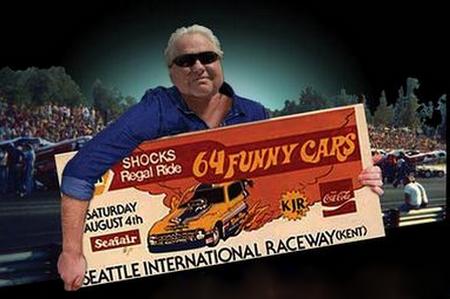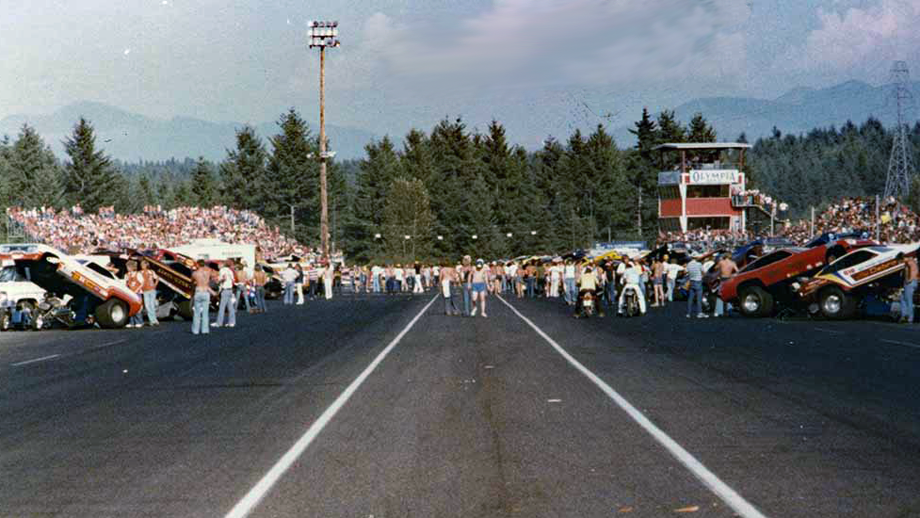DONER MAGIC PART OF PACIFIC RACEWAYS LORE

Wistfully, Doner said, “A sight to behold,” as if he were describing majestic Mount Rainier or a bald eagle perched on a lush, green branch.
It all seemed so peaceful – until the gates swung open at Seattle International Raceway for the night. The sun went down, the header flames went up into the night sky, and bedlam erupted. Bill Doner was in the house, on the microphone, reveling in his role as the maestro of mayhem.
It was 64 Funny Cars, a beloved part of Northwest racing legend, and Doner was smitten. He promised that “nothing in all of motorsports like Funny Cars at night.”
The whole scene stoked the romance of drag racing for John Force, who said he got his start in the sport when Doner was running Southern California’s Orange County International Raceway. He called Doner “the greatest promoter of all time” and knew if he followed him to Seattle, he’d have a memorable time. And he has, from the days when swarms of fans scurried from the grandstands down to the track and would look in the race-car windows when drivers were doing their burnouts to last Sunday, when he earned his 150th victory. And Doner was there for both ends of Force’s career.
Doner was responsible for 64 Funny Car ads that Northwest residents – even ones who aren’t particularly drag-racing fans – talk about today, 40 years later.
"When the ads came on the radio, people didn't turn the radio down -- they turned it up! They loved the ads. They'd go to the major rock stations and listen for our ads. If we weren't on the air on that station, the kids wouldn't listen to it. The 64 Funny Car ads were so powerful that people bring that up to this day," he said.
And he knew how to get and keep a crowd’s attention. “We could get 'em so whipped up that if you weren't there, people would throw rocks at you. It was the biggest deal ever!" Doner said.
 Those were the days, when former Seattle promoter Jim Rockstad said he saw the largest crowd ever at the Seattle racetrack, 26,000-plus, for the '79 edition of 64 Funny Cars."
Those were the days, when former Seattle promoter Jim Rockstad said he saw the largest crowd ever at the Seattle racetrack, 26,000-plus, for the '79 edition of 64 Funny Cars."
They came to see the biggest names in Funny Car racing: Raymond Beadle, Jim Dunn, Jungle Jim Liberman, Dale Pulde, Li’l John Lombardo, Gary Densham, Gene Snow, Joe Pisano, Gordy Bonin, Roger Lindamood, Dale Creasy, Tripp Shumake, Al Hanna, Twig Ziegler, Kenney Goodell, Mike Miller, Dave Uyehara, Terry Capp, and a long list of their rivals.
So Doner set the bar for drawing and entertaining crowds at Pacific Raceways, which during his tenure was called Seattle International Raceway. Rockstad is retired, and Jason Fiorito operates the facility. And one of the fixtures every August is the legend himself, Bill Doner.
He’s 80 now, and he still delights with that same twinkle in his eyes. His sense of promoting is just as keen as it was, his powers of observation just as strong. And during last weekend’s Magic Dry Organic Absorbent Northwest Nationals, Doner reminisced, shared some thoughts about how to revive interest in the sport, and what to do about going head-to-head with the entrenched local hydroplane-centric festival Seafair, and some surprising facts about the facility.
“When I came here, this was a road course. That’s what I came up here to see, not the drag race. It was a 2.25-mile, nine-turn road course down through the trees. First year I was here, we put on the Indianapolis cars . . . 1969, it was Al Unser Sr.’s first win on a road course, Mario Andretti won the first heat. Of course, we had to run in the rain. First time we ever ran in the rain with Indy cars – something to see . . . 200-mile heats . . . Dan Gurney 200 we called it. It was terrific. We had a wonderful Trans Am [Series] so we ended the year with that Indy car race.”
And that was the only champ-car event at Seattle.
 “I had been working with Carroll Shelby and had done some work with Gurney. I was involved with those guys. I had been back in Indy that year. That was the Mario Andretti’s only win in Indianapolis in 1969, the only time he ever won it. So he came right up here for that, and we had almost everybody. A.J. Foyt didn’t come, but pretty much all the Indy car guys did. We had the turbo Fords and all of them out there. It was something to see. It was a little late in the year and I didn’t know my way around quite as well as I should have. You’re going up against football and stuff up in the Northwest. We had the greatest TransAm [Series] we’d ever seen that year. That series was fabulous. We had all the Penske cars, Mark Donahue and Gurney, Parnelli [Jones], and Peter Revson. All the factory cars were out here. It was good stuff. That was when the Fords won the championship that year. Jerry Titus won it. That was Shelby’s team that I worked for before.”
“I had been working with Carroll Shelby and had done some work with Gurney. I was involved with those guys. I had been back in Indy that year. That was the Mario Andretti’s only win in Indianapolis in 1969, the only time he ever won it. So he came right up here for that, and we had almost everybody. A.J. Foyt didn’t come, but pretty much all the Indy car guys did. We had the turbo Fords and all of them out there. It was something to see. It was a little late in the year and I didn’t know my way around quite as well as I should have. You’re going up against football and stuff up in the Northwest. We had the greatest TransAm [Series] we’d ever seen that year. That series was fabulous. We had all the Penske cars, Mark Donahue and Gurney, Parnelli [Jones], and Peter Revson. All the factory cars were out here. It was good stuff. That was when the Fords won the championship that year. Jerry Titus won it. That was Shelby’s team that I worked for before.”
Soon, though, he saw the value of drag racing. Even back then, without X-Games-style extreme being any kind of buzz, without social-media, cell phones, and computers, Doner had his finger on the pulse of what people want. With drag racing, he knew he could deliver it. And the longstanding Seafair event didn’t frighten him at all. One year his SIR program was so strong that Seafair moved its date to avoid a problem.
Doner said, “Rather than do what they’re doing, I never tried to go in and battle with Seafair. I was well aware [of it]. But this is a wonderful opportunity to utilize what they’re doing. So how’s that work? Well, it works like this: We’re going to run on Saturday night and we’re going to pour advertising over in Canada and we’ll make sure these people know they can park for free down at Lake Washington when they’re drunk and can sleep in their cars and the boat race was free then on Sunday and then they can go home. How can you miss out on this weekend?
“I always knew excitement breeds excitement,” he said.

“All the stations televised [Seafair] all the same day. All three are televising all day long, six hours straight of this boat race all over town. They’ve all got towers, they’re down on Lake Washington. You’re not going to get an ounce of coverage. Next day the front page of the [Seattle] Times is going to have a big picture of a rooster tail, not some Funny Car. That’s not going to work,” he said.
“Now if you run on Saturday night . . . They said, ‘Well, what would you do?’ I said, ‘I’ll tell you what I will do.’ I went down to [radio station] KJR, which was then the No. 1 rocker in town. And I said, ‘I want to buy a lot of time. I want to be able to broadcast the final run, the last 30 minutes of my 64 Funny Cars live on KJR. I want you to advertise all week that I’m going to broadcast on the radio. Kids can tune in and listen to it. I’m going to have Blue Max and the Hawaiian out here doing burnouts and I’m going to be screaming in the tower.’ And we did that. We broadcast live. It came on the air at 10:30. I knew we were going to run at 11. So I made that happen like that,” Doner said. “Whenever the final was, we gave them the results.”
Doner asked the current management, “Why don’t they run this qualifying Saturday night? Saturday night or even tomorrow night? He said the lights. I said, ‘It’s light out here until nine o’clock at night. What do you have to do? Go rent some lights and put a bunch of lights up. That’s bologna. Why do you have to run on Friday when nobody comes to things on a Friday afternoon? People work up here. Instead of running at 3 p.m. and 5 p.m., run at 6 p.m. and 9 p.m. Let the people know that. Don’t even open the gates till 11 a.m.’”
 That might not happen, but it’s always wise at least to consider a suggestion from Bill Doner.
That might not happen, but it’s always wise at least to consider a suggestion from Bill Doner.
Doner’s reputation stretched back to the East Coast, where Mike Lewis, now a vice-president at Don Schumacher Racing, was affected a continent away.
“All the cars would come to Maple Grove [near Reading, Pa.]and Englishtown, but they’d all leave for the month of August, it might have been July but they’d be gone for a period of time,” he said. “We kept getting all these stories about wild and crazy it was when Bill Doner promoted 64 Funny Cars here and paid these guys astronomical sums of money, compared to what we paid them back East. He’d be paying $2,500 to $3,000. We’d be paying $1,500 to $2,000 and I’m talking about the 1970s. That’s what a match car race would be paid to run anywhere in the country, except Seattle, and they came out here and put on a great show.
“The fans here those days were standing-room-only. I can still picture, and I was never here, but I can see pictures of 64 Funny Cars lined up here all fired up at the same time. It challenged us back East to do bigger shows and better shows and to encourage our fans to cut loose and have fun.”
And that was and still is the operative word with Doner: fun.
Get the @competitionplus Mobile APP to get your drag racing news quick and easy. - https://t.co/HsiKEmdZXO pic.twitter.com/qpgtrHqnpr
— Competition Plus (@competitionplus) January 4, 2019







































